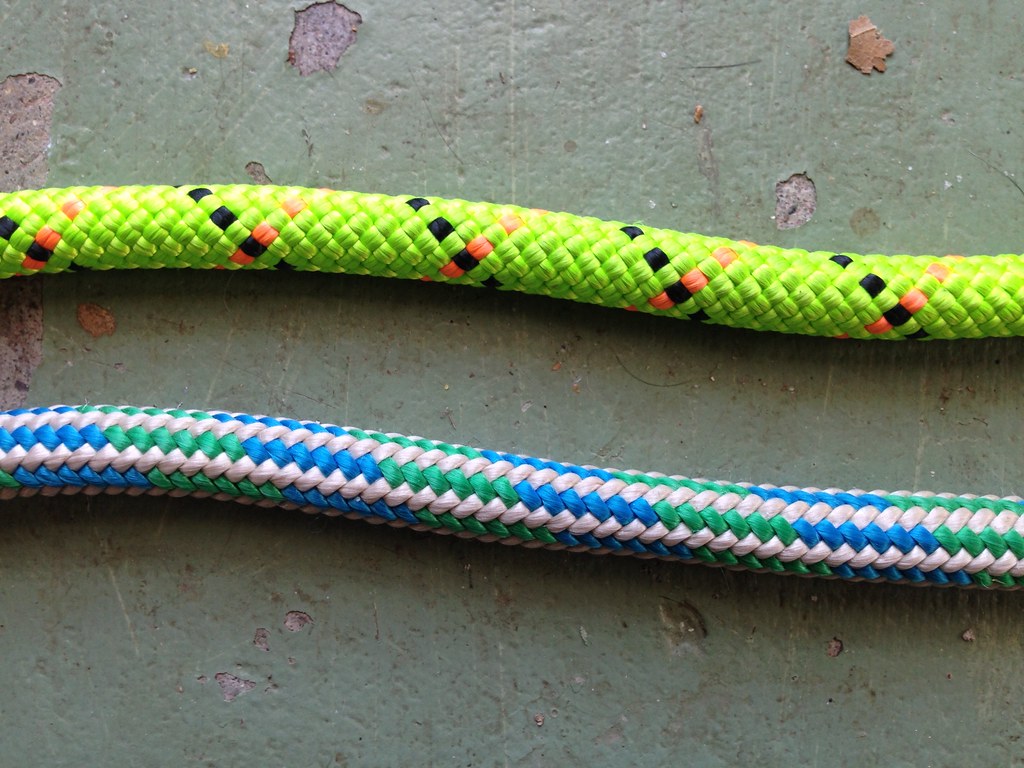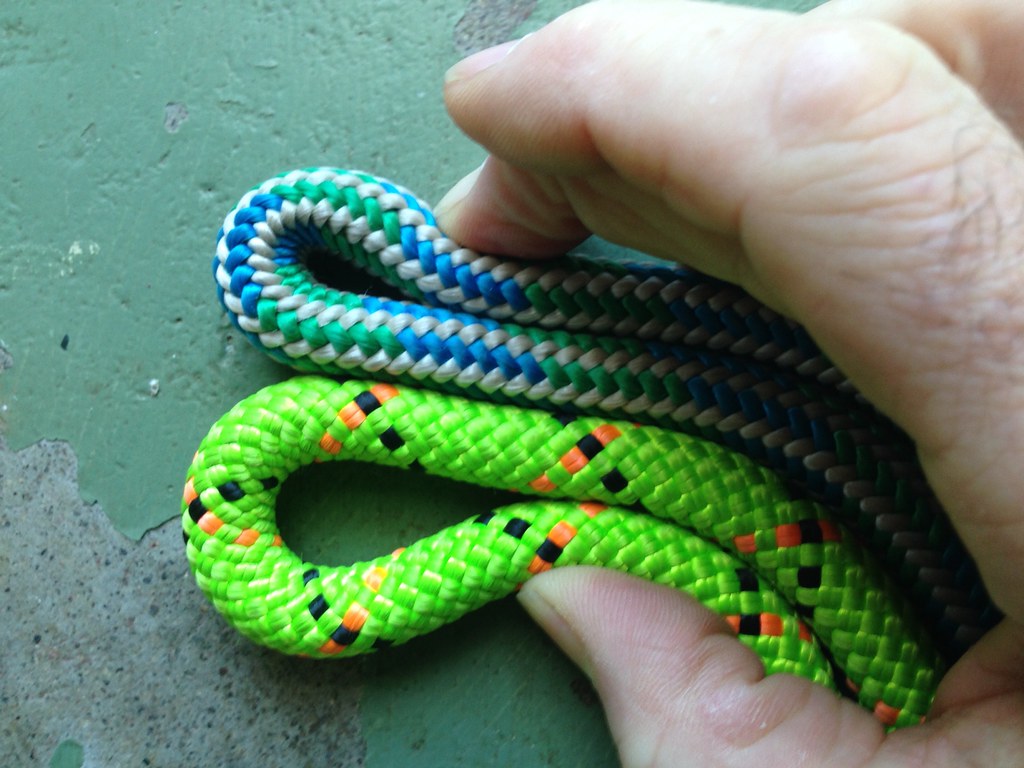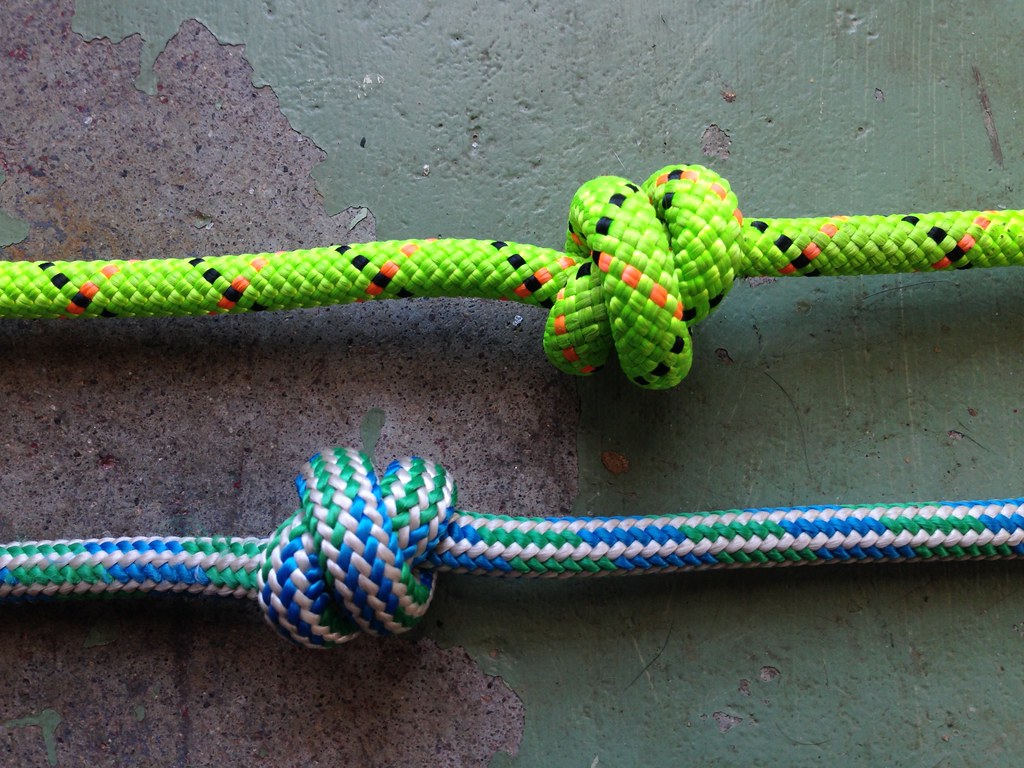- Posts: 6
- Thank you received: 0
Light, long-lasting rope? Preventing wear?
- KristinaC
-
 Topic Author
Topic Author
- Offline
- Fresh Boarder
-

I would normally just buy another Samson Velocity, but I feel like it didn't last as long as I hoped it would. Maybe I was too hopeful?. Or is there a better option for me?
We hike long distances with our rope and other equipment, so definitely want something light.
We monitor ~ 30 trees at a time so we leave a thin cord in each tree fork and just use the cord to pull the rope up through the fork (directly over the bark).
We tie one end of the rope to the base of a tree, then use Petzl ascenders to go up the other end, and an ATC belay device to come (slowly) down.
I think most of my rope damage/wear results from: 1) Rope gets caught on thorny bamboo, sticks, etc, branches when we are pulling it up. 2) Ascenders damage the rope as we're climbing. 3) When coming down we tend to have problems with heat in the ATC if we go too fast (so we try to descend slowly, but then we tend to spin a lot, especially as the rope gets older, and extra rope goes into a curly pig-tail on the ground). Tree trunks are not straight, and we usually aren't close enough to keep our feet on them as we're descending. Even after straightening the rope, I usually find we still have that spinning and curling problem on the next climb.
I'm willing to spend more for a lighter, longer-lasting rope, if such a thing exists. Also thinking it might be time to replace my ascenders or ATC if they could be damaging the rope more than they should - both are several years old, look to be in excellent condition but...might they be shortening the life of my rope?
I hope this isn't the most boring question you ever heard - I did a search of previous posts but wasn't able to find what I'm looking for. Thanks in advance for any advice you can offer.
Kristina
Please Log in or Create an account to join the conversation.
- moss
-

- Offline
- Platinum Boarder
-

- Posts: 1915
- Thank you received: 93
I agree with your theory that the rope fuzz you see is primarily surface wear from installing ropes. In my mind the next problem is the ATC, it's putting a very tight bend radius on the rope during descent, that shortens rope life in the long run. The ATC and the Petzl Ascension ascender are designed primarily for kernmantle construction ropes, that is a rope that derives all of its strength from the core, the cover is thick, woven very tightly. The cover's job is to protect the core from abrasion. Kernmantle ropes are relatively stiff, not supple. They cannot be used for Blake's Hitch climbing for example. A rope like Velocity is a double-braid construction. It has a core braid and a cover braid. The strength of the ropes is shared between the core and the cover. So the strength and the working life of the rope is more effected by daily surface wear than a kernmantle rope. Double braid construction ropes are very supple and were originally designed with arborist climbing in mind, very knottable, can be self tied as a Blake's Hitch doubled rope (DRT) system etc.
For the kind of climbing you're doing I believe a kernmantle construction rope is a better choice. To shave weight but keep your safety factor where you want it I recommend something like Sterling HTP 10mm or a Bluewater II 10.5mm. 11mm kernmantles are generally heavier than an 11mm double-braid like Velocity. It depends on the fiber materials used in a kernmantle, for example Sterling HTP is a very dense polyester fiber, it is heavier per foot of rope than a nylon or standard polyester core fiber. You could theoretically find an 11mm kernmantle that has reasonable weight per foot. Most online rope sellers will give you the weight per foot in the rope specs.
Velocity is a great rope but not the best choice for what you're doing. A certain amount of fuzz on a double braid is normal, any chance you can post a photo?
In general, for whatever rope construction you use, a better descent device would improve your safety and climbing experience. There are many devices out there that would be a big improvement over the ATC. The Petzl Rig is excellent, ISC D4 is another. The nice thing about the two devices is you can set up a RADS or Yo-Yo ascent system. The RADS allows you descend quickly without a complicated switchover if for example you were attacked by wasps during ascent.
And then there are the SRT multicender devices, this is the new frontier. I climb on them 90% of my work and rec climbs. This is just something for you to look at and research. The Singing Tree Rope Wrench is the most simple and intuitive. Many reasons to like it but number one is fully functional smooth ascent and descent on a single rope without performing a switchover. Rope Wrench is hitch based (uses a split tail hitch cord with the Rope Wrench) Feel free to PM me to discuss further or continue the discussion here or both
Disclaimer: Discussing potentially advanced techniques here, for people who have not learned to climb SRT yet, there is a lot to consider in regard to safe rope placement, proper gear choice and use etc.
-Andrew Joslin
Please Log in or Create an account to join the conversation.
- KristinaC
-
 Topic Author
Topic Author
- Offline
- Fresh Boarder
-

- Posts: 6
- Thank you received: 0
Thank you so much - I have learned so much already from your answer.
So, the double braid is not the best choice for what we do! Glad to hear there's a better option. We aren't tying knots in the rope, other than our anchor knot. So my next rope will be kernmantle, and I'll find a better alternative to the ATC.
The ascenders we use are Petzl Left and Right Ascenders (attaching a photo). I forgot to mention that we always use a chest harness and two foot-stirrups, and we sometimes use a positioning lanyard to get close enough to inspect nests.
I don't have a photo of the fuzz on the ATC, unfortunately - I left my equipment in the field. I got a friend to take a photo of the worst section of the rope itself (attached). The fuzz that was coming off was definitely visible on the ATC every time we descended, but not tons of it; I never found fuzz on the ascenders. I've never had fuzz before using this ATC with this rope or other Velocity ropes. (I've also never had a rope that looks this frayed!!!). Interested to know if you think the rope is totally unsafe, or could still be used for some climbing applications (e.g. climbing on the other end, or lopping off this end and using the rest of it for shorter trees).
I sent you a PM about the options for descenders.
Thanks again,
Kristina
Please Log in or Create an account to join the conversation.
- moss
-

- Offline
- Platinum Boarder
-

- Posts: 1915
- Thank you received: 93
Your "jugging" (two ascender setup) system looks excellent. RADS would be a good skill to add to your mental toolkit, it's nice to make quick height adjustments up or down when you're up there without messing with changing climb modes. I'll try and make a video next few days showing some positioning and on-rope adjustments on a RADS.
For any well used rope many mechanical SRT devices will strip fuzz so no worries there. It's more about how many strands are broken and maybe even more importantly your gut feeling about the rope. As mentioned, I would want to stop using that section of rope.
-AJ
Please Log in or Create an account to join the conversation.
- moss
-

- Offline
- Platinum Boarder
-

- Posts: 1915
- Thank you received: 93
If anyone has tried a Petzl Rig on 10mm HTP please chime in. A .5mm difference in diameter is very likely safe but the question is how well does it perform.
There are many 10.5 mm static ropes (kernmantles) available, the question is can you find one that isn't too bouncy. Bluewater II (now Bluewater II+) 10.5mm was my first SRT rope and I was happy with it at the time.
-AJ
Please Log in or Create an account to join the conversation.
- moss
-

- Offline
- Platinum Boarder
-

- Posts: 1915
- Thank you received: 93
The rope that Kristina and her team are using is 11mm Samson Velocity. Velocity weighs 5.6 lbs. per 100' of line and is a 24-strand double-braid. It is light but as with all arborist double braids has a relatively soft/supple cover braid which is vulnerable to "picking" and abrasion. Double-braid ropes share the load with the core and cover which makes abrasion damage more problematic. DRT climbers typically use cambium savers which reduces abrasion as a problem.
For SRT use in more extreme environments simply installing a rope can subject it to excessive abrasion. Static kernmantle ropes typically have a much more abrasion resistant cover, the strength is carried by the core, the cover is designed to protect the core and carries no load.
So the goal of this excercise is to find a static kernmantle rope that is in the weight range of 5.6 lb. per 100' and meets the spec of currently available self-braking descent devices. By self-braking I mean that the device meets the "hands-off test" or "whistle test". If a climber takes their hands off the device will they go to the ground or will they stay where they are on rope? The ATC device currently used by Kristina's team does not meet the whistle test. So the goal is to find a low stretch static kernmantle that meets the weight per 100' requirement and that is within the 10.5mm - 12mm rope spec required by currently available self-braking descenders.
Sterling WorkPro Kernmantle 11mm
5.6 lbs. per 100', 8,092 MBS (maximum breaking strength), elongation at 10% of max strength 3.4%
http://wesspur.com/items/wp15.html
Notes: Described as compatible with the newer SRT multicender rope tools like the Rope Wrench, Rope Runner and Akimbo (to be released 2018)
Edelrid Performance 11mm
5.3 lbs per 100', 6,969 MBS, elongation at 10% of max strength 3.4%
http://wesspur.com/items/wp15.html
Notes: No free luch, a lighter rope of the same diameter will be stretchier. No info on multicender compatibilty, assume not.
Petzl Parallel 10.5mm
5 lbs per 100', 4,946 lb MBS elongation at 10% of max strength 3.4%
http://wesspur.com/items/pe15.html
Notes: Even less free lunch, very light weight but significantly lower MBS, still within minimum strength standard of 22kn. Because of the lower breaking strength the elongation spec of 3.4% at 10% is in reality going to be stretchier than the first two ropes above. I would want to to try before buying. Climbing SRT on a rubber band isn't much fun
For comparison:
Sterling HTP 10mm
5.3 lb per 100', 5,979 lb MBS, 1.7% elongation at 300 lb
http://wesspur.com/items/ht3815.html
Notes: Very low stretch, the preferred access/SRT line for Pacific Northwest research climbers. Very durable, really shines for long ascents where the extremely low stretch improves climber efficiency. Gold standard for lightweight rope access in challenging environments.
I inquired in the greater climber community about HTP 10mm compatibility with the Petzl Rig or ISC D4 (minimum 10.5mm rope spec). Had one report of a climber who used it with the Rig in industrial work positioning climbing and said it worked well. They had not done any long rappels on it. The question there is can you get a smooth ride or not?
-AJ
Please Log in or Create an account to join the conversation.
- KristinaC
-
 Topic Author
Topic Author
- Offline
- Fresh Boarder
-

- Posts: 6
- Thank you received: 0
Please Log in or Create an account to join the conversation.
- moss
-

- Offline
- Platinum Boarder
-

- Posts: 1915
- Thank you received: 93
KristinaC wrote: Thank you so much for this detailed analysis, Andrew, this is terrific. The WorkPro 11 mm kernmantle looks like a good solid choice for our needs, and no heavier than our soon-to-be-retired Velocity double braid. I will definitely replace the ATC with a self-braking device, probably the RIG. Looking forward to trying it all out!
I remembered that I have a short length of Sterling WorkPro 11mm that a supplier gave me as a sample when it first came out. I measured it with a caliper, it is a true 11mm, often ropes don't quite match up to the specified diameter. In hand it is much less supple than Velocity which is expected but has good knotability. The cover has a very tight weave, looks to be durable as advertised.
Some photos comparing WorkPro (light green) and Velocity...
WorkPro has a denser cover with "double carrier" strands in the weave, Velocity is single carrier which makes it supple but allows the strands to pick more easily.
WorkPro has a wider bend radius, which is expected with the heavier cover
Comparing a double overhand stopper knot, WorkPro's is a little bulkier but sets well
-AJ
Please Log in or Create an account to join the conversation.
- wingtrip
-

- Offline
- Fresh Boarder
-

- Posts: 3
- Thank you received: 0
I also appreciated hearing these thoughts too, because I am in the market for new rope for SRT!
Please Log in or Create an account to join the conversation.
- KristinaC
-
 Topic Author
Topic Author
- Offline
- Fresh Boarder
-

- Posts: 6
- Thank you received: 0
The birds I study are tree-cavity-nesting birds in subtropical forest in Argentina, so: toucans, parrots, owls, songbirds, woodpeckers, forest-falcons, anything that nests in a tree hole.
My sense is that most people studying cavity-nesters in North America don't bother to climb the trees, because nests tend to be lower (accessible by pole-mounted camera or ladder) and in dead trees. However I know researchers do climb Red-cockaded Woodpecker trees and they sometimes seek technicians with climbing experience. Mostly the people who are climbing trees to study bird nests are studying parrots or - eek!- raptors. And mostly in the tropics is my guess. A bit in Australia.
You can read about some cavity nesting researchers in this magazine article: https://www.sciencenewsforstudents.org/article/trees-come-down-some-hidden-homes-are-disappearing
And my own research here:
https://sites.google.com/site/kristinacockle/research
Have a look at the Birdjobs-L e-list for job postings about bird research. I've not seen much paid work involving tree climbing but you never know.
Feel free to email me if you have more questions....(address is on that second site).
Kristina
Please Log in or Create an account to join the conversation.
- steve-o
-

- Offline
- Fresh Boarder
-

- Posts: 8
- Thank you received: 1
I too am looking for a better & lighter RADS rope than my Voyager and will he on the lookout for some Kernmantle.
Will it work equally as well on a rope wrench setup?
Please Log in or Create an account to join the conversation.
- moss
-

- Offline
- Platinum Boarder
-

- Posts: 1915
- Thank you received: 93
steve-o wrote: Great writeup AJ! Another great contribution to the board.
I too am looking for a better & lighter RADS rope than my Voyager and will he on the lookout for some Kernmantle.
Will it work equally as well on a rope wrench setup?
Yale Kernmaster Safari 11mm is a kernmantle construction line that works well with the Zk-2 Rope Wrench, 5.5 lbs per 100' which is pretty light weight. Some kernmantles like the Sterling HTP lines are not great with the wrench.
-AJ
Please Log in or Create an account to join the conversation.
- Erickem
-

- Visitor
-

Please Log in or Create an account to join the conversation.
- MichaelGonzales88
-

- Offline
- Fresh Boarder
-

- Posts: 3
- Thank you received: 0
Please Log in or Create an account to join the conversation.
Join Our Mailing List
Tree Climbers International, Inc.
1284 Merry Lane NE
Atlanta, GA
30329-3923
USA
Email us
Phone: 404-377-3150
Proud supporter of:

Website by 3by400, a north Georgia web design team using Joomla!


